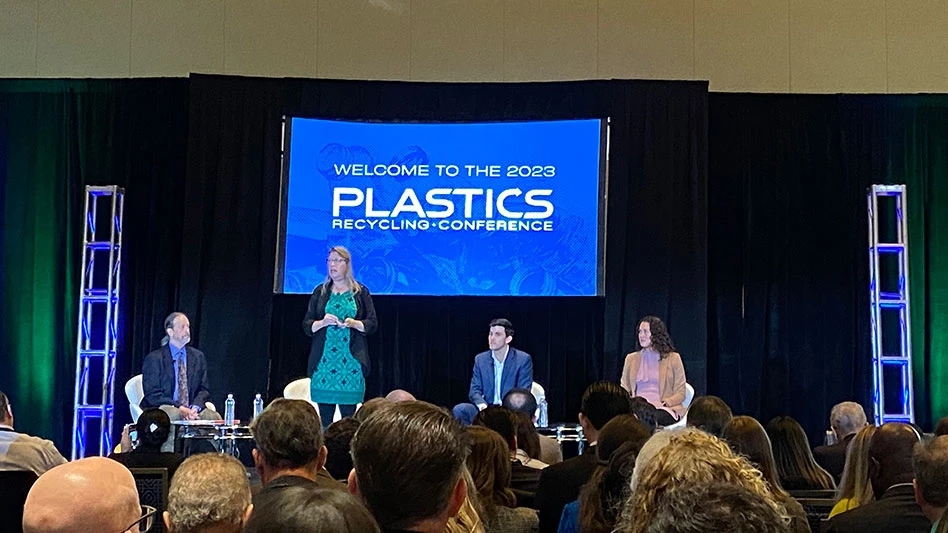
Photo by DeAnne Toto
Analysts from ICIS, Wood Mackenzie and PetroChem Wire spoke to the trends influencing plastic recycling during a session at the 2023 Plastics Recycling Conference, hosted by Resource Recycling in partnership with its parent company, the Association of Plastic Recyclers (APR).
“Everyone wants recycled material,” said Andrew Brown of Wood Mackenzie, headquartered in London. “It’s a good problem to have.”
That demand is driven by decarbonization efforts by companies throughout the plastics value chain, he said, adding that recycling is an economically viable and immediate means for doing so.
Roughly 25 million tons of polyethylene terephthalate (PET) are used annually in packaging applications, with recyclate demand growing in Western countries, Brown said. Led by the U.K.-based Ellen MacArthur Foundation in collaboration with the UN Environment Programme, consumer packaged goods companies that are signatories to the Global Commitment have targeted including 26 percent recycled content in their packaging by 2025.
Apparel accounts for 36 million tons of polyester demand, he said, with demand for recycled content primarily centered in Asia. Textile Exchange, Lamesa, Texas, has set a target of 45 percent recycled content in textiles by 2025, with companies such as Adidas, Banana Republic, H&M Group and Madewell among the brands that have signed on to this goal.
Brown said that while 3 million tons of rPET capacity are forecasted to be added by 2025, nearly five times that amount will be needed to meet the Ellen MacArthur and Textile Exchange targets.
Brands have a few options available for securing additional rPET supply, he said, including increasing collection of end-of-life bottles, new technologies to improve sorting and chemical recycling. Brown added that legislation offers the best chance for improving collection, though the U.S. has yet to achieve a cohesive national standard by which to do so. He said if Europe’s approach were to be applied in the U.S., it could increase collection by 10 percent to 20 percent. Digital watermarking, chemical tracers, robotics, artificial intelligence and near-infrared sorting could help to improve bale quality and yield from 65 percent to 70 percent to 70 percent to 75 percent, while Brown predicted that chemical recycling will play a significant role in the next 15 to 20 years.
He said he expected imports of rPET flake into the U.S. to increase, particularly from Latin America, in the coming years.
Emily Friedman, a recycled plastics senior editor at ICIS who works out of Houston for the London-based firm, said recycled plastic capacity growth is occurring largely in North America, Europe and Asia; however, Asian production likely will be routed to meet demand in the U.S. and Europe. The U.S. also is importing recycled flake and pellets from Latin America.
She added that bales of plastic from the U.S. have been shipped to Asia and Latin America as well as to Europe at points over the last year, depending on the market dynamics, to meet reclaimer demand, while recycled flake and pellets also are being shipped from the U.S. to Europe.
“Last year, with record high freight prices, a lot of these pathways were disrupted,” Friedman said. “But this year, we are in a totally different state. … I think 2023 and 2024 are really going to be where we see true growth with some of these supply chain patterns forming in the region.”
In addition to importing U.S. bales, Europe is importing recycled flake and pellets from the Middle East and Asia, Friedman indicated in her presentation.
Europe is driving the pace of plastics-related legislation globally, she said. Legislation in the region includes the Packaging Directive, which seeks to harmonize national measures on packaging and management of packaging waste; the Circular Economy Package II, which seeks to ensure reusable packaging options are available, eliminate unnecessary packaging and provide clear labels to support correct recycling; and the Single-Use Plastics Directive, which seeks to prevent and reduce the environmental impact of certain plastic products and promote a transition to a circular economy.
Friedman said Europe is setting the model for recycled plastic content requirements and that what is happening there now “will be coming down the pipeline to us in five to 10 years or so. So, even if those pieces of legislation don’t directly impact your market today” they could in the future.
In the U.S., five states—California, Washington, New Jersey, Connecticut and Maine—have passed laws that set recycled-content minimums, affecting the demand side, while on the supply side “EPR [extended producer responsibility] is a huge topic of interest not just in Europe but also in the U.S.,” she said. Seven states have reintroduced EPR legislation this year, while four states—Maine, Oregon, Colorado and California—already have passed EPR laws for packaging.
Additionally, Asian regulations regarding the shipment of plastic scrap still is affecting the world market, Friedman said. “Different countries are individually saying we are no longer going to be accepting or shipping plastic waste, and that is a huge disrupter to their supply chains.”
While people think of Europe as a mature market, she said they might be surprised to learn that at the peak of the supply and demand imbalance last year, pricing for rPET flake and pellet was similar in Europe and the U.S. Friedman said that while supply is more developed in Europe, demand may be more aggressive.
European demand for rPET is driven by bottle or thermoform and sheet production, while in the U.S. it is driven by bottle or fiber production, Friedman says. Given that difference, as fiber demand for rPET fell in the autumn of last year in the U.S., pricing crashed. “But during that time, Europe didn’t see that same change.” That created the opportunity to ship between the U.S. and Europe, she added.
Asian prices are lower than in the U.S. and Europe, “especially if you’re playing export game because you have to account for freight.”
Kathy Hall, executive director of product management for global petrochemicals at PetroChem Wire, by Maryland-based OPIS, a Dow Jones company, said there has always been a correlation between virgin and recycled plastic prices, with PET and rPET long having operated in a “harmonious” relationship.
PetroChem Wire focuses on providing pricing data for virgin and recycled plastics.
Hall said the commoditization of recycled plastics is “just another indicator of how big [this industry] is becoming.”
She said commoditization of the sector also will work to weed out the “bad actors,” adding, “Standards will be the backbone of success.”
The Plastics Recycling Conference was March 6-8 at the Gaylord National in National Harbor, Maryland.
Get curated news on YOUR industry.
Enter your email to receive our newsletters.
Latest from Recycling Today
- Republic Services, Blue Polymers open Indianapolis recycling complex
- Altilium produces EV battery cells using recycled materials
- Brightmark enters subsidiaries of Indiana recycling facility into Chapter 11
- Freepoint Eco-Systems receives $50M loan for plastics recycling facility
- PET thermoform recycling the focus of new NAPCOR white paper
- Steel Dynamics cites favorable conditions in Q1
- Hydro starts up construction in Spain
- Green Cubes unveils forklift battery line





